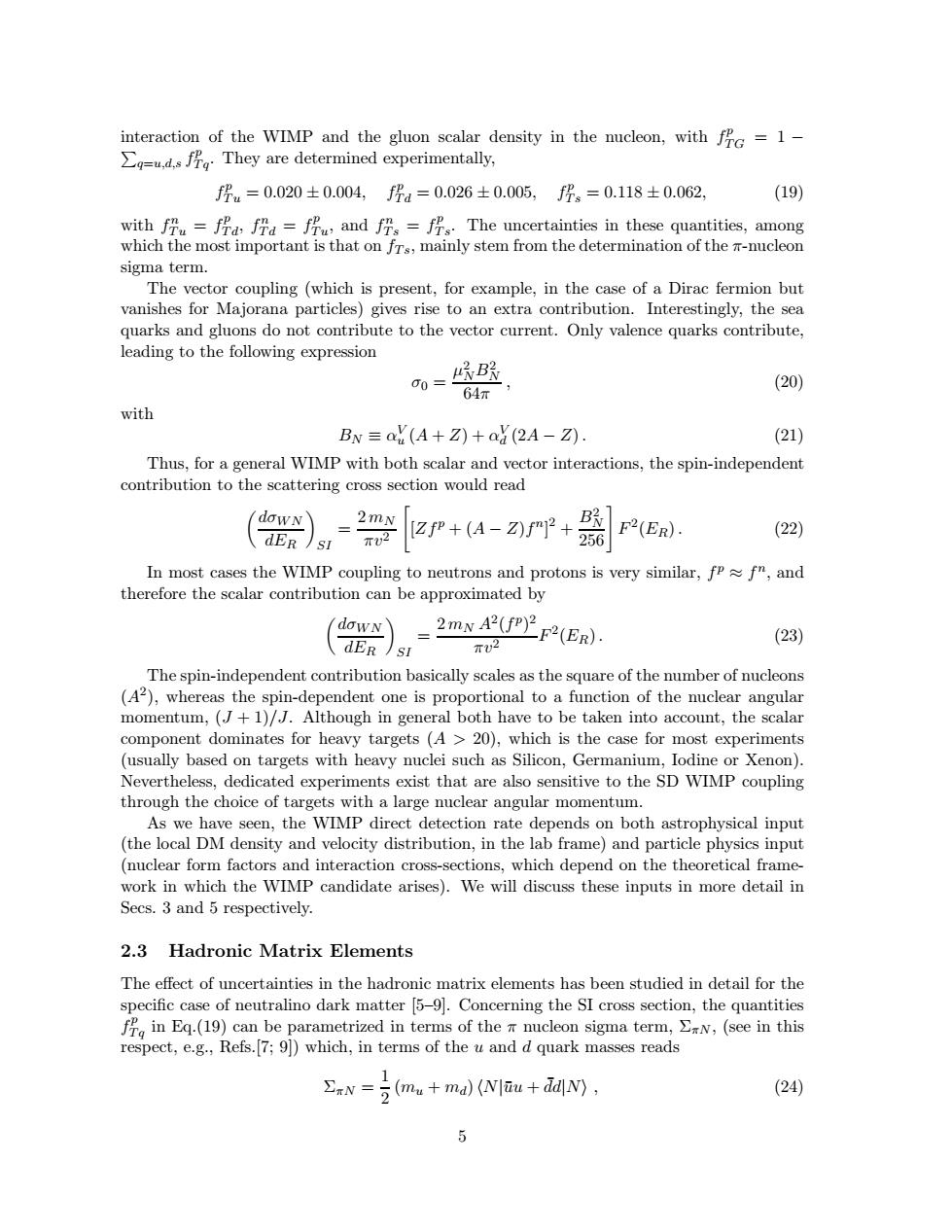正在加载图片...

interaction of the WIMP and the gluon scalar density in the nucleon,with fc =1- They are determined experimentally, fu=0.020±0.004,fa=0.026±0.005,fs=0.118±0.062, (19) with fru=frd,fra=fr,and frs=frs The uncertainties in these quantities,among which the most important is that on frs,mainly stem from the determination of the m-nucleon sigma term. The vector coupling (which is present,for example,in the case of a Dirac fermion but vanishes for Majorana particles)gives rise to an extra contribution.Interestingly,the sea quarks and gluons do not contribute to the vector current.Only valence quarks contribute, leading to the following expression 00= B路 (20) 64π with BN=av(A+Z)+a(2A-Z) (21) Thus,for a general WIMP with both scalar and vector interactions,the spin-independent contribution to the scattering cross section would read dowN 2mN dER sI [Zf+(A-Z)f")2+ B 256 F2(ER) (22) In most cases the WIMP coupling to neutrons and protons is very similar,fp fn,and therefore the scalar contribution can be approximated by dowN 、dEr/sI 2mN A((ER). (23) TU2 The spin-independent contribution basically scales as the square of the number of nucleons (A2),whereas the spin-dependent one is proportional to a function of the nuclear angular momentum,(J+1)/J.Although in general both have to be taken into account,the scalar component dominates for heavy targets (A 20),which is the case for most experiments (usually based on targets with heavy nuclei such as Silicon,Germanium,Iodine or Xenon). Nevertheless,dedicated experiments exist that are also sensitive to the SD WIMP coupling through the choice of targets with a large nuclear angular momentum. As we have seen,the WIMP direct detection rate depends on both astrophysical input (the local DM density and velocity distribution,in the lab frame)and particle physics input (nuclear form factors and interaction cross-sections,which depend on the theoretical frame- work in which the WIMP candidate arises).We will discuss these inputs in more detail in Secs.3 and 5 respectively. 2.3 Hadronic Matrix Elements The effect of uncertainties in the hadronic matrix elements has been studied in detail for the specific case of neutralino dark matter [5-9].Concerning the SI cross section,the quantities f in Eq.(19)can be parametrized in terms of the nucleon sigma term,N,(see in this respect,e.g.,Refs.7;9])which,in terms of the u and d quark masses reads N(m+m)(Nlu+d), (24) 5interaction of the WIMP and the gluon scalar density in the nucleon, with f p T G = 1 − P q=u,d,s f p T q. They are determined experimentally, f p T u = 0.020 ± 0.004, f p T d = 0.026 ± 0.005, f p T s = 0.118 ± 0.062, (19) with f n T u = f p T d, f n T d = f p T u, and f n T s = f p T s. The uncertainties in these quantities, among which the most important is that on fT s, mainly stem from the determination of the π-nucleon sigma term. The vector coupling (which is present, for example, in the case of a Dirac fermion but vanishes for Majorana particles) gives rise to an extra contribution. Interestingly, the sea quarks and gluons do not contribute to the vector current. Only valence quarks contribute, leading to the following expression σ0 = µ 2 N B2 N 64π , (20) with BN ≡ α V u (A + Z) + α V d (2A − Z). (21) Thus, for a general WIMP with both scalar and vector interactions, the spin-independent contribution to the scattering cross section would read dσW N dER SI = 2 mN πv2 " [Zf p + (A − Z)f n ] 2 + B2 N 256# F 2 (ER). (22) In most cases the WIMP coupling to neutrons and protons is very similar, f p ≈ f n , and therefore the scalar contribution can be approximated by dσW N dER SI = 2 mN A2 (f p ) 2 πv2 F 2 (ER). (23) The spin-independent contribution basically scales as the square of the number of nucleons (A2 ), whereas the spin-dependent one is proportional to a function of the nuclear angular momentum, (J + 1)/J. Although in general both have to be taken into account, the scalar component dominates for heavy targets (A > 20), which is the case for most experiments (usually based on targets with heavy nuclei such as Silicon, Germanium, Iodine or Xenon). Nevertheless, dedicated experiments exist that are also sensitive to the SD WIMP coupling through the choice of targets with a large nuclear angular momentum. As we have seen, the WIMP direct detection rate depends on both astrophysical input (the local DM density and velocity distribution, in the lab frame) and particle physics input (nuclear form factors and interaction cross-sections, which depend on the theoretical framework in which the WIMP candidate arises). We will discuss these inputs in more detail in Secs. 3 and 5 respectively. 2.3 Hadronic Matrix Elements The effect of uncertainties in the hadronic matrix elements has been studied in detail for the specific case of neutralino dark matter [5–9]. Concerning the SI cross section, the quantities f p T q in Eq.(19) can be parametrized in terms of the π nucleon sigma term, ΣπN , (see in this respect, e.g., Refs.[7; 9]) which, in terms of the u and d quark masses reads ΣπN = 1 2 (mu + md)hN|uu¯ + ¯dd|Ni , (24) 5